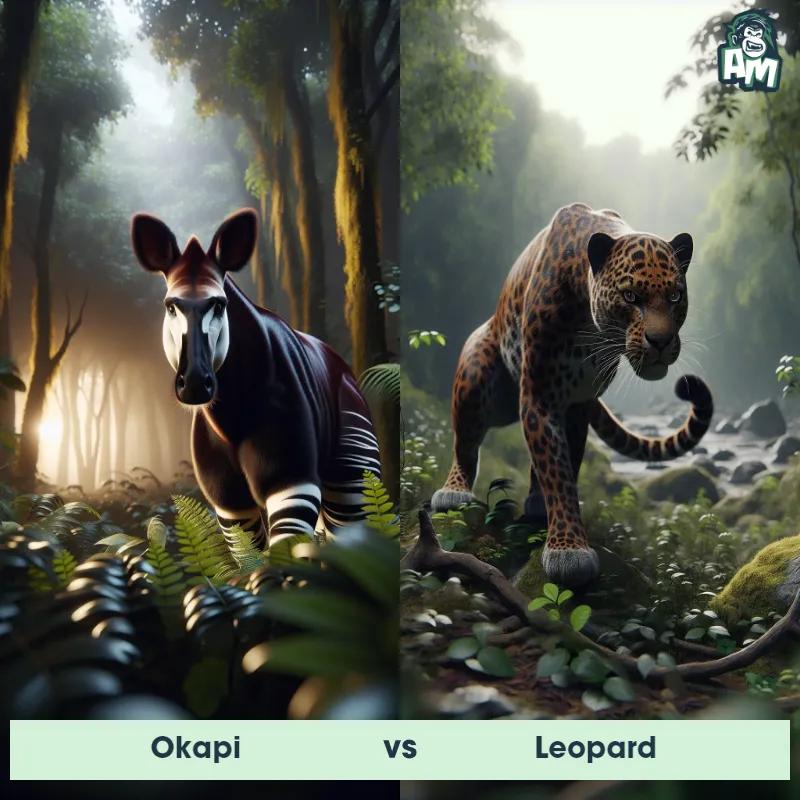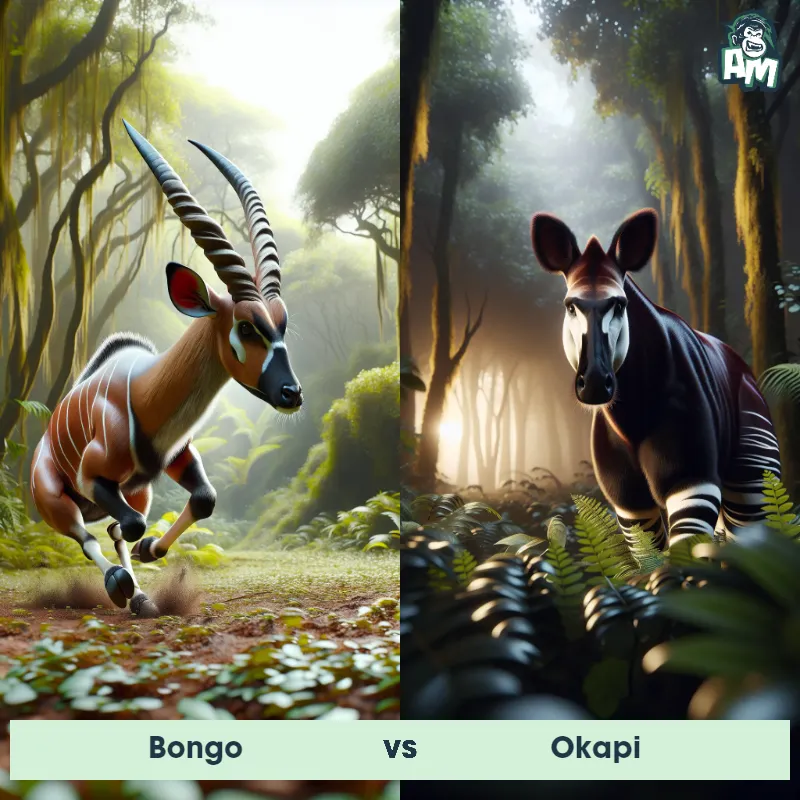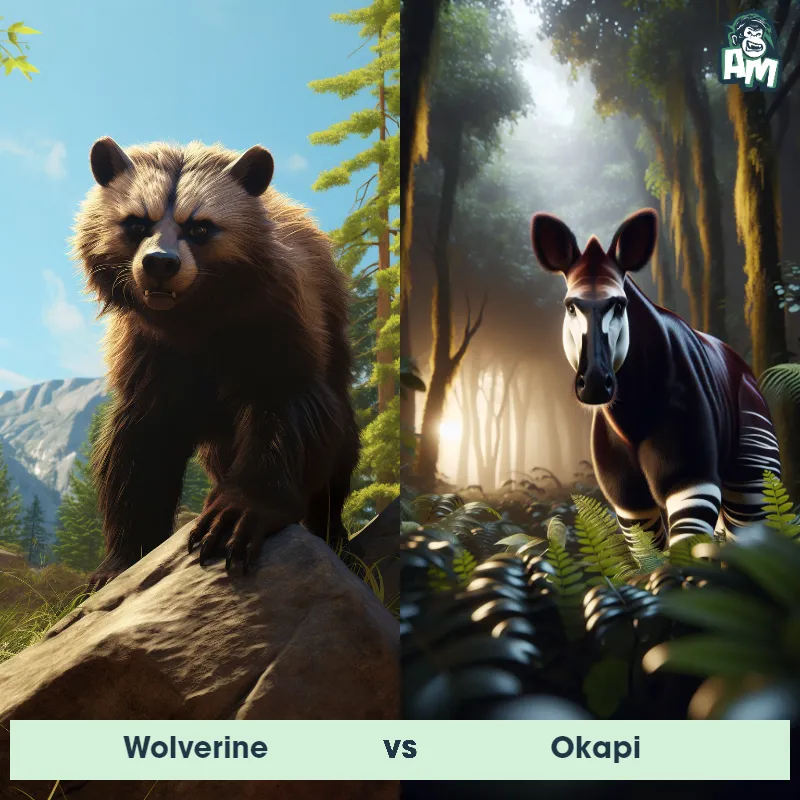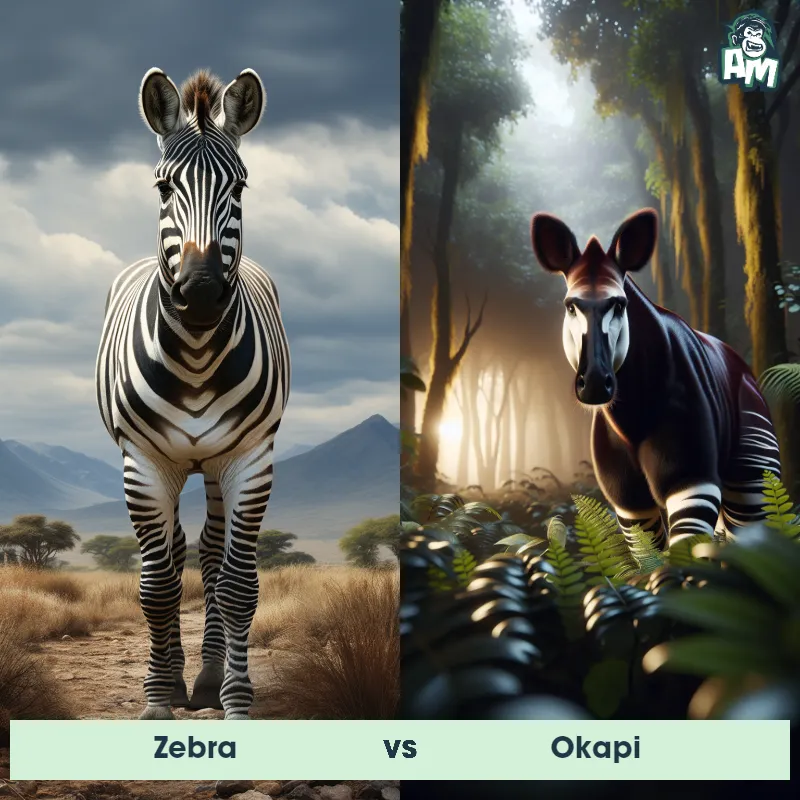The Okapi
The Okapi, also known as the forest giraffe, is a unique and elusive mammal native to the dense rainforests of Central Africa. It has a horse-like body structure with a striking combination of physical features resembling both a giraffe and a zebra. Okapi's most distinguishing feature is its long and flexible black tongue, similar to that of a giraffe, which it uses to manipulate foliage and feed on leaves, buds, and fruits. With its reddish-brown velvety coat adorned with horizontal white and black stripes on its hindquarters and legs, the Okapi blends seamlessly into its forest habitat, making it incredibly well-camouflaged.

| Okapi | |
|---|---|
| Size | 5-6 feet (1.5-1.8 meters) at the shoulder |
| Weight | 440-770 pounds (200-350 kilograms) |
| Speed | 37mph (60km/h) |
| Key Strength | Agile and fast, capable of delivering powerful kicks |
| Biggest Weakness | Vulnerable to neck and head attacks due to its long neck |
| Scientific Name | Okapia johnstoni |
| Family | Giraffidae |
| Habitat | Dense rainforests |
| Geography | Central Africa |
| Diet | Herbivorous, feeds on leaves, fruits, and buds |
| Lifespan | 25 years - 30 years |

The Okapi
The Okapi, also known as the forest giraffe, is a unique and elusive mammal native to the dense rainforests of Central Africa. It has a horse-like body structure with a striking combination of physical features resembling both a giraffe and a zebra. Okapi's most distinguishing feature is its long and flexible black tongue, similar to that of a giraffe, which it uses to manipulate foliage and feed on leaves, buds, and fruits. With its reddish-brown velvety coat adorned with horizontal white and black stripes on its hindquarters and legs, the Okapi blends seamlessly into its forest habitat, making it incredibly well-camouflaged.
Fun Fact: The Okapi has an extraordinary sense of hearing and can rotate its large rounded ears independently to detect sounds from different directions, allowing it to be alert to potential threats or prey while maneuvering through the dense vegetation of the rainforest.
| Okapi | |
|---|---|
| Size | 5-6 feet (1.5-1.8 meters) at the shoulder |
| Weight | 440-770 pounds (200-350 kilograms) |
| Speed | 37mph (60km/h) |
| Key Strength | Agile and fast, capable of delivering powerful kicks |
| Biggest Weakness | Vulnerable to neck and head attacks due to its long neck |
| Scientific Name | Okapia johnstoni |
| Family | Giraffidae |
| Habitat | Dense rainforests |
| Geography | Central Africa |
| Diet | Herbivorous, feeds on leaves, fruits, and buds |
| Lifespan | 25 years - 30 years |
Okapi Matchups
We use AI to simulate matchups between the Okapi and other animals. Our simulation considers size, strength, and natural predatory behaviors to determine the most likely outcome.

Can't find the Matchup you want?
Create Your Own MatchupOkapi: Diet, Predators, Aggression, and Defensive Behaviors
What do Okapis eat?
Okapis are herbivores, primarily feeding on leaves, buds, fruits, and fungi. They are known to have a special preference for certain plant species, such as vines, shrubs, and fruits found in the dense rainforest where they reside.
Do Okapis have any predators?
Yes, Okapis have natural predators such as leopards and humans. Leopards often prey on young or sick Okapis, while humans hunt them for their meat, skin, and body parts. Hunting and deforestation are major threats to the Okapi population.
Are Okapis aggressive?
Okapis are generally solitary and peaceful animals. They are known to be shy and elusive, preferring to avoid confrontation. However, they may become aggressive when threatened or during mating season, displaying defensive behavior to protect themselves or establish dominance.
Do Okapis fight?
Okapis typically avoid physical conflicts and only resort to fighting when necessary, such as during territorial disputes or mating rituals. Males may engage in sparring matches using their ossicones (horn-like structures on their heads) to establish dominance and mating rights.
How do Okapis defend themselves?
Okapis rely on their keen senses, agility, and camouflage to evade predators. They have excellent hearing and sense of smell, allowing them to detect danger and escape quickly into the dense vegetation. Okapis also have powerful legs and can run at high speeds to evade threats.
What is the biggest weakness of the Okapi in a fight?
The Okapi's biggest weakness in a fight is its relatively small size and vulnerability to predators. Despite their agility and speed, Okapis can easily be overpowered by larger predators such as leopards. Their solitary nature and peaceful demeanor also make them susceptible to attacks when caught off guard.
Fun Fact: Despite its physical similarities to zebras, the Okapi is more closely related to giraffes. Both giraffes and Okapi belong to the same family, Giraffidae, making them the only living members of this unique family.
Fun Fact: Female Okapis have a gestation period of about 14 to 15 months, which is one of the longest gestation periods among mammals. They usually give birth to a single calf, which can stand and walk within an hour after being born, allowing it to quickly keep up with its mother in the dense forest.















